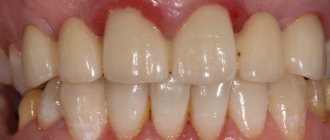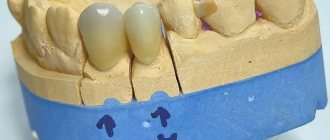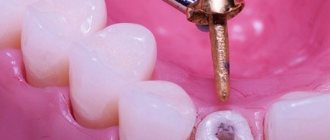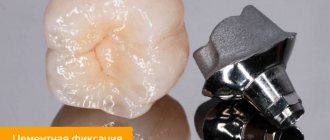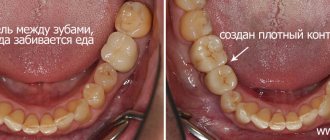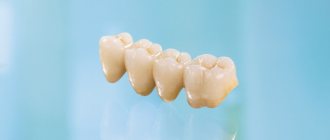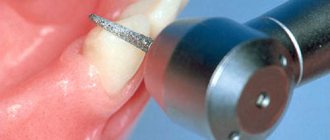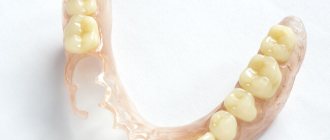- Service life of different types of crowns
- Late crown replacement
- When to change a crown
- How to change crowns
- How often are crowns replaced?
- Additional videos
Sooner or later, most people have to deal with dental prosthetics.
Perhaps the most common type of prosthetics is the so-called “dental crown” (more information about different crowns here). Many patients are their owners, but only a few patients ask questions: do dental crowns need to be replaced, how often should dental crowns be changed, etc.
Let's try to figure it out.
What is the service life of different types of crowns?
As you know, any structure has a certain service life. Unnecessarily long use can lead to dire consequences.
So: how often should crowns be replaced?
It is believed that the average service life of a crown is 5-7 years. At one time, scientists proved that it is after such a period of time that the cement on which the crown is fixed begins to undergo changes. But this does not mean that the crown must be changed every 5 or 7 years. During this period, a doctor should evaluate it to understand whether it can still serve or whether the crown needs to be replaced.
In addition to the duration of use, during a preventive examination, the doctor evaluates the following parameters: the quality of the marginal fit of the crown to the tooth, the condition of the gums and bone tissue next to the crown, X-ray data of the tooth, patient complaints, etc.
Cement
Another way to glue a dental crown at home? For this, another effective remedy recommended by dentists can be used. This is a dental cement that can retain its properties for over 10 years. But permanent cement is not intended for home use. Installing a crown yourself can only be done using a temporary solution. Its fixation period is longer than that of glue. But you need to be careful not to overdo it and ruin the prosthesis, since excess dental cement can make it unsuitable for subsequent procedures.
Before purchasing, it is still better to consult a doctor about which product is best to choose. Cement for dental crowns is not sold in every pharmacy. Moreover, there are both cheap and expensive options. Cement "Provicol" and "Meron" cost over 1,500 rubles. They include 2 components that must be mixed before use. Cheap products include zinc phosphate cements - “Adgezor”, “Unifas”, “Unitsem”. The cost for them is no more than 300 rubles per package. And “Tsemion F” costs about 350 rubles. When choosing any product, you need to find out about compatibility with the crown.
What determines the service life of a crown?
- The service life and the need to replace the structure greatly depend on the accuracy of manufacturing at all stages. Precision work means that the crown fits to the tooth without gaps, without steps, without voids, oral fluid and food do not get under it, the gums around it do not become inflamed, it is no different from the “native” tooth. It is the precision of manufacturing that determines the quality of work, and therefore is the key to a long service life of the crown. For example, I had to deal with a situation where the crown was made only a year ago, and upon examination, strict indications for its urgent replacement were revealed (due to poor quality, namely inaccurate manufacturing). And vice versa, when examined, the crown meets all the requirements, all parameters are normal, there is no need to replace it, and it has been standing for 10 years (which means it was manufactured very accurately and in a timely manner).
- We have repeatedly mentioned that accuracy, and therefore quality, is at the forefront. If we take quality as a given, then the material and method of fixation come to the fore. So, the service life also depends on the material from which the crown is made and, accordingly, on the method of fixing it to the tooth . Classic metal-ceramics and zirconium dioxide-based crowns are attached to a special “cement,” that is, an intermediary between the crown and the tooth, and do not enter into a “chemical” bond with either this cement or the ground tooth. Namely, this cement is “destroyed” and “washed out” over time, leading to a violation of the seal of the entire structure. Crowns based on lithium disilicate (also called “E-max”) are fixed without an intermediary: using the adhesive (“glue”) method, that is, they are glued to the tooth tissue, which leads to a very strong connection between the crown and the tooth. Accordingly, the service life of such structures is longer than the 5-7 years described above, which means that a crown change will not be required soon.
- In addition, the service life is greatly influenced by the condition of the tooth for which the crown was made. If a patient hesitates for a long time to adequately restore a damaged tooth, he comes for prosthetics at an untimely rate, in particular when the tooth is destroyed by a carious process to the level or below the level of the gum, becoming “soft” and unreliable. In such conditions, the doctor is no longer able to make an accurate marginal fit; such a structure will never be completely sealed, which means the tooth under such a crown will be destroyed. In such conditions, neither good materials nor the method of fixing the crown will help. And if the doctor nevertheless undertakes the restoration of such a tooth, this will be the last crown on it, since it will be impossible to repeat the restoration.
Important! Dear patients, do not delay the restoration of damaged teeth, do not deprive yourself of the opportunity to save your own tooth faster, more reliably and cheaper!
By clicking on the “Make an appointment” button, I consent to the processing of my personal data.
I have read and agree with the conditions for processing personal data set out on the website ds-chocolate.ru.
Consent to the processing of personal data
Popular means
Dental stores sell many products for fixing crowns. There are many manufacturers, and many of them produce reliable products. How to glue a dental crown at home? The best types of glue are:
- "Rox". The product is produced in Russia, performing fixation for 12 hours. The glue is economical, since one tube is used within 1.5-2 months. Since it contains no harmful dyes, it is considered completely safe.
- "Forest Balsam" Used in the dental field to secure both removable and partial dentures. This glue ensures high-quality fastening of crowns during chewing. The composition contains rose hips and chamomile, which prevent inflammation. The tube is designed so that the glue can be conveniently applied to the desired surface.
- "Lakalut." High-quality fixing agent produced by a German manufacturer. Compared to its competitors, this product secures dentures for a day. Once secured, the denture cannot fall off during chewing or speaking.
- "The president". This product is available in almost all dental stores and pharmacies. Vaseline and various flavorings were used during production, so if the crowns were installed recently, it is not advisable to use such a product. The fixation weakens when eating hot food.
- "Fittydent." If you have severe sensitivity, this glue should not be used, as its application can lead to unpleasant sensations in the gums. To eliminate problems after application, you should wait before fixing the structure.
- "Protefix". For dentures, this is an effective tool that reliably fixes crowns for up to 12 hours. The composition contains mint and aloe, making the glue hypoallergenic.
- "Corega." Petrolatum, zinc, and paraffin were used to create the glue. The combination of these components ensures maximum fixation of the prosthesis without a negative effect on the body. There are several types of products from this manufacturer. Among them are refreshing and adhesive for strong fixation.
These are not all means for fixing dental crowns; there are over 30 of them. You need to know all the features of each means in order to choose the most suitable option.
What are the consequences of untimely crown replacement?
1. Destruction of the tooth under the crown with its subsequent loss.
The main function of a crown is to restore a badly damaged tooth and protect it. The first time after installation, the crown performs its function perfectly. But after a certain time, changes occur. The gingival margin rises, saliva and gingival fluid affect the cement that “secures” the crown. Over time, this cement can be partially washed out (dissolved), a microscopic gap is formed between the crown and the tooth, and the tooth begins to deteriorate under the influence of microbes and oral fluid. The most insidious thing is that these signs occur asymptomatically and unnoticed by the patient, since they are painless. Therefore, replacement of crowns often occurs untimely, when the tooth is destroyed too much and becomes simply unreliable.
Associated with this is the myth that teeth under crowns are destroyed. The truth is that crowns are simply replaced at the wrong time, but too late.
This can be prevented by timely replacement of the orthopedic structure.
2. Inflammation of the tissues around the crown . This means the gums, tooth ligament and bone tissue. A poor-quality crown can lead to the formation of a chronic inflammatory process in the gums (gingivitis, periodontitis), which is manifested by redness, bleeding when brushing teeth, aching pain in the gums and an unpleasant odor. If such a crown is not replaced for a long time, the underlying tissues become involved in the inflammatory process, which may lead to the formation of bone pockets, disruption of the ligamentous apparatus of the tooth, and local periodontitis, which in severe cases leads to tooth loss.
Photo 2.1. Inflammation of the gums near teeth under crowns, associated with inaccurate marginal fit of the crown to the tooth and with a violation of the biological parameters of tooth restoration.
Important! Make it a rule to visit the dentist for a preventive examination at least once a year, if you have any dentures, in order to notice their failure in time and prevent or correct the problem.
Types of adhesive for dentures
As a rule, a person encounters this medical composition only in the dental office, when a specialist installs dentures or crowns for him. However, if necessary, you can glue the tooth yourself. If you have a financial problem and it is not yet possible to visit the dentist, you can temporarily use glue for dental crowns. Such medications have different compositions, depending on the technology of the manufacturing company.
Features of denture adhesives from several popular brands are shown in the following table:
There is a wide selection of such products on the shelves of pharmacies, and the best adviser on which adhesive to choose for dentures will be the dentist who installed the dental structures.
How do you know if it’s time to change the crown or if it can still serve?
There are objective signs that reflect the condition of crowns/bridges, which are assessed by an orthopedic dentist during a routine examination:
- service life of the crown/prosthesis
- patient complaints (pain, food getting stuck near the crown, unpleasant odor near the crown, and others)
- fit of the crown to the tooth (marginal fit)
- the presence of areas of plaque accumulation
- condition of the gums next to the crown (color, bleeding, density, presence of other signs of inflammation, raising the edge of the gums (exposure of the root))
- presence of signs of inflammation of the bone tissue around the tooth with a crown
- density of interdental contact (crowns with adjacent teeth).
If one or a number of signs are present, the doctor decides whether the crown needs to be replaced.
When should you see a doctor?
Cement and glue contain zinc, which with frequent use, albeit in small quantities, penetrates into the blood. Copper deficiency gradually develops, as evidenced by the appearance of:
- nausea;
- graying of hair or severe baldness;
- pain in the gastrointestinal tract;
- metallic taste in the mouth.
If any of the above symptoms occur, you should consult a doctor. If, in addition to the detached crown, injuries and inflammation appear in the mouth, then urgent medical attention is needed.
Can the patient himself understand that it is time to replace the crown?
Certainly! There are a number of signs, the presence of which should give cause for concern.
- The most common is crown edge exposure , when the gingival margin rises and the tooth root becomes visible (“gingival recession”). In this case, root caries may develop, that is, the tooth may be destroyed.
Photo 2.2. The initial stage of exposure of the roots of the teeth under the crowns.
Photo 2.3. The advanced stage of exposure of the roots of the teeth under the crowns.
- Inflammation of the gums around the crown , which manifests itself in redness of the gums, swelling, and bleeding when brushing.
Photo 2.4. Inflammation of the gingival margin of teeth under crowns, associated with inaccurate marginal fit of the crown to the tooth and with a violation of the biological parameters of tooth restoration.
- The appearance of crown mobility . Patients often say that the crown or bridge is “fixed.” This happens especially often when several crowns are combined (some of the crowns of the bridge have become uncemented, while the rest are still holding together).
- The appearance of an unpleasant odor or taste in the crown area.
- Food getting stuck between crown/crown and tooth.
Important! All of the above signs are a mandatory reason to visit the dentist.
Prosthesis repair
There are two options for repairing an acrylic prosthesis:
In accordance with manufacturing technology:
- making a plaster cast;
- sequential technological actions associated with obtaining a sprue for spraying a hardening polymer composition;
- final grinding and polishing of the restored prosthesis.
Urgent repairs:
- Cleaning and degreasing broken prosthesis;
- Drying;
- Application of adhesive composition;
- Drying;
- Grinding and polishing of seams.
Which of these options to resort to is up to you. Before starting the repair, it should be noted: the cost of repairing an acrylic prosthesis in a dental workshop is 10-15% of the cost of making a new one. To technologically restore a prosthesis you will need to purchase:
- Polymer composition in the cartridge;
- High quality dental plaster;
- Vibrating table;
- Insulating varnish;
- Dental wax.
The cost of these materials is very high. The main problem is that they are not sold at retail. Order through companies or the Internet - go without teeth for at least 2 weeks.
Instant repair allows you to restore the integrity of the prosthesis for 5-10 days and wait for the opportunity to contact a professional - a dental technician.
How are crowns replaced?
A separate article will be devoted to this. Let us briefly describe the main stages:
Stage 1 : examination by a doctor and diagnosis (X-rays). We evaluate the accuracy of the crown fit, the condition of the tooth and surrounding tissues. We understand that the crown needs to be replaced.
2nd stage : silicone key (necessary for the doctor to make you a temporary crown so that you do not go without a tooth after removing the old one)
Stage 3 : we evaluate the tooth under the crown, give it the correct shape, clean it, and remove possible caries. We fix the temporary crown. You can't go a day without a tooth!
Stage 4 : we take impressions for the new crown and send them to the dental laboratory.
Stage 5 : we get a new crown, fix it on the tooth and happily say goodbye to the doctor until the next professional examination.
Modeling and installation of temporary structures
Provisional crowns are made in two ways: direct and indirect. The first makes it possible to receive the finished product within an hour.
- The orthopedist takes a silicone impression.
- Grinds the tooth.
- Plastic is poured into the impression and placed on the prepared tooth.
- Then the impression is taken. The hardened plastic product remains in place.
- The orthopedist can only grind off the excess, grind and polish the new one.
The indirect method is used in laboratory conditions, using silicone, plaster and wax. This method gives more effective results. A temporary crown best matches the anatomy of the patient’s jaw; it is more reliable and durable.
Bottom line: how long does it take to replace crowns?
According to the book rules : in 5-7 years.
It is better to replace poorly made crowns immediately after placement, so that the teeth underneath do not deteriorate.
Well-made crowns can last 10 years or more.
Conclusion: any crown has a certain service life, which depends on the characteristics of the clinical situation (tooth condition), quality of workmanship, material and method of fixation. The need for replacement is determined by the doctor based on a number of objective factors. Timely replacement allows you to reuse the same foundation (tooth, root) to repeat the structure. Accordingly, the tooth will last for many years. Untimely replacement of the crown (unreasonably long use) can lead to deep tooth destruction, which will be impossible to restore.
An attentive attitude to one’s health on the part of the patient, coupled with timely and qualified assistance from a doctor, leads to a long-term positive result.
By clicking on the “Make an appointment” button, I consent to the processing of my personal data.
I have read and agree with the conditions for processing personal data set out on the website ds-chocolate.ru.
Consent to the processing of personal data
Be healthy!
